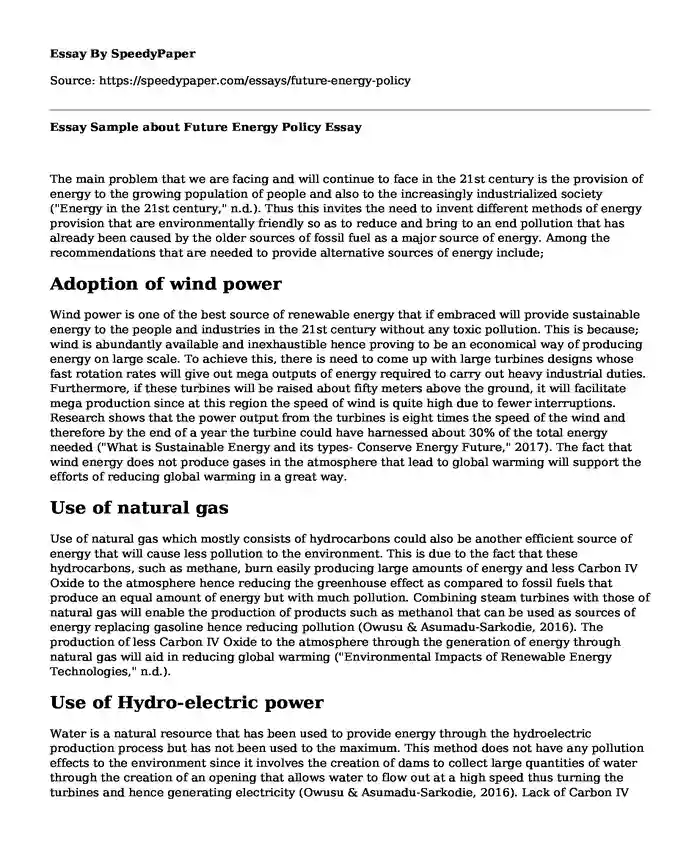The main problem that we are facing and will continue to face in the 21st century is the provision of energy to the growing population of people and also to the increasingly industrialized society ("Energy in the 21st century," n.d.). Thus this invites the need to invent different methods of energy provision that are environmentally friendly so as to reduce and bring to an end pollution that has already been caused by the older sources of fossil fuel as a major source of energy. Among the recommendations that are needed to provide alternative sources of energy include;
Adoption of wind power
Wind power is one of the best source of renewable energy that if embraced will provide sustainable energy to the people and industries in the 21st century without any toxic pollution. This is because; wind is abundantly available and inexhaustible hence proving to be an economical way of producing energy on large scale. To achieve this, there is need to come up with large turbines designs whose fast rotation rates will give out mega outputs of energy required to carry out heavy industrial duties. Furthermore, if these turbines will be raised about fifty meters above the ground, it will facilitate mega production since at this region the speed of wind is quite high due to fewer interruptions. Research shows that the power output from the turbines is eight times the speed of the wind and therefore by the end of a year the turbine could have harnessed about 30% of the total energy needed ("What is Sustainable Energy and its types- Conserve Energy Future," 2017). The fact that wind energy does not produce gases in the atmosphere that lead to global warming will support the efforts of reducing global warming in a great way.
Use of natural gas
Use of natural gas which mostly consists of hydrocarbons could also be another efficient source of energy that will cause less pollution to the environment. This is due to the fact that these hydrocarbons, such as methane, burn easily producing large amounts of energy and less Carbon IV Oxide to the atmosphere hence reducing the greenhouse effect as compared to fossil fuels that produce an equal amount of energy but with much pollution. Combining steam turbines with those of natural gas will enable the production of products such as methanol that can be used as sources of energy replacing gasoline hence reducing pollution (Owusu & Asumadu-Sarkodie, 2016). The production of less Carbon IV Oxide to the atmosphere through the generation of energy through natural gas will aid in reducing global warming ("Environmental Impacts of Renewable Energy Technologies," n.d.).
Use of Hydro-electric power
Water is a natural resource that has been used to provide energy through the hydroelectric production process but has not been used to the maximum. This method does not have any pollution effects to the environment since it involves the creation of dams to collect large quantities of water through the creation of an opening that allows water to flow out at a high speed thus turning the turbines and hence generating electricity (Owusu & Asumadu-Sarkodie, 2016). Lack of Carbon IV Oxide production through this process of energy production make hydropower an ideal source of energy to reduce global warming. However, more funds will have to be allocated to this area to ensure more dams are built along the river courses to ensure maximum utilization of the resource and energy production.
Use of solar energy
Solar energy is one of the cheapest sources of sustainable energy that can be used in this era of the 21st century since it involves a simple and cheap procedure for energy production and does not have any pollution effects to the environment as it releases no gases to the atmosphere that result to global warming. The heat energy produced by the sun is trapped by the solar panels and transformed to electric energy that can be used at home and even in the industries according to the power of the panels used since the larger and more advanced the solar panel, the higher the amount of energy generated (Owusu & Asumadu-Sarkodie, 2016. This energy can be stored in batteries to ensure that there is a continuous supply of energy even after the summer season when the amount of solar energy goes down during winter. Therefore, solar energy use will lead to a reduction in the levels of global warming that have come from fossil fuels.
It is therefore upon you to look into adopting the above recommendations as the techniques involved have little or no effects on the environment and therefore, if they are funded and put into practice they will help in the provision of energy to increasing population, industrialization as well as support the efforts by the government to reduce global warming.
References
Energy in the 21st century. (n.d.). Retrieved from http://pubs.acs.org/subscribe/archive/ci/31/i01/html/01chen.html
Environmental Impacts of Renewable Energy Technologies. (n.d.). Retrieved from https://www.ucsusa.org/clean-energy/renewable-energy/environmental-impacts#bf-toc-3
Owusu, P. A., & Asumadu-Sarkodie, S. (2016). A review of renewable energy sources, sustainability issues and climate change mitigation. Cogent Engineering, 3(1). doi:10.1080/23311916.2016.1167990
What is Sustainable Energy and its types- Conserve Energy Future. (2017, January 5). Retrieved from https://www.conserve-energy-future.com/sustainableenergy.php
Cite this page
Essay Sample about Future Energy Policy. (2022, May 24). Retrieved from https://speedypaper.net/essays/future-energy-policy
Request Removal
If you are the original author of this essay and no longer wish to have it published on the SpeedyPaper website, please click below to request its removal:
- Free Essay Disclosing ObamaCare Pros and Cons
- Free Essay on What Being a Leader Means
- Reflection on Race, Essay Example
- How Do Choices Shape Your Destiny? Free Essay about O.J. Simpson
- Varicella Vaccinations, Essay Sample for Free Use
- Portrait of Sebastian Juner Vidal, 1903 - Art Essay Sample for Students
- Data Visualization Essay Example
Popular categories





